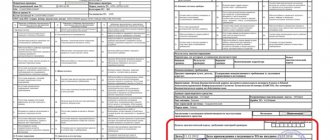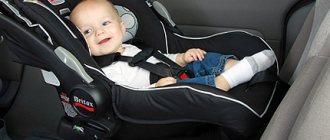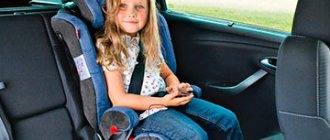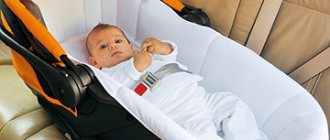All over the world, children's car seats are divided into groups according to the weight and height of the child. This classification is reflected in the European standards ECE 44 or ECE 129 (i-Size), which are also supported by the Technical Regulations of the EAEU Customs Union. Dividing into groups allows you to select a model in accordance with the age of the child.
| Group | Weight, kg | Approximate age |
| 0 | 0-10 | from birth to 6 months |
| 0+ | 0-13 | from birth to 1 year |
| 1 | 9-18 | from 9 months to 4 years |
| 2 | 15-25 | from 3 to 7 years |
| 3 | 22-36 | from 6 to 12 years |
Combined groups
There are car seats that combine the functions of several groups at once. Such seats are convenient when moving from one group to another, when the child in the seat of one group has already grown up, but is still too small for the other. As a rule, buying a universal seat is cheaper than car seats of 0, 1, 2 and 3 groups separately.
The following groups are most often combined:
| Group | Weight, kg | Approximate age |
| 0+1 | 0-18 | from birth to 4 years |
| 0+1-2 | 0-25 | from birth to 7 years |
| 1-2 | 9-25 | from 1 year to 7 years |
| 1-2-3 | 9-36 | from 1 year to 12 years |
| 2-3 | 15-36 | from 3 to 12 years |
To accurately select the right car seat group, use the table of the approximate weight and height of the child depending on his age.
Universal car seat
Such chairs are sold labeled “group 0-1-2-3” and should be suitable for children from 0 to 12 years old. You can change the angle of the chair on the plastic base, the height of the headrest and remove additional soft inserts.
Pros:
- The chair will last a long time - from 0 to 12 years of age;
- If you buy a chair in the middle price segment, you can save money. If you buy expensive chairs, the savings are insignificant.
Minuses:
- the crash test results of such seats are worse than those of models made for a specific age group;
- Often these chairs are uncomfortable - anatomical pads and inserts do not always suit the child.
Svetlana Novikova, safe driving instructor, mother of 4 children The quality, comfort and safety of such seats highly depend on the manufacturer - look for crash tests of a specific model. If there is no data on safety tests, it is better not to buy such a chair. The rule “the more expensive the better” works with them.
For an infant, the angle of the universal chair should be closer to 100°. When the child grows up, the soft black inserts can be removed. Source: ozon.ru
Age, weight and height appropriate for boys
| Age | Weight, kg | Height, cm |
| 1 month | 4,3 | 54 |
| 2 months | 5,1 | 57 |
| 3 months | 5,8 | 60 |
| 4 months | 6,6 | 63 |
| 5 months | 7,2 | 66 |
| permissible difference | +/- 0,8 | +/- 4 |
| 6 months | 7,9 | 68 |
| 7 months | 8,4 | 70 |
| 8 months | 8,8 | 72 |
| 9 months | 9,2 | 73 |
| 10 months | 9,7 | 74 |
| 11 months | 10,2 | 75 |
| permissible difference | +/- 1,5 | +/- 4 |
| 12 months | 10,4 | 76 |
| 1.5 years | 11,6 | 82 |
| 2 years | 12,7 | 88 |
| 2.5 years | 13,7 | 93 |
| permissible difference | +/- 2,5 | +/- 6 |
| 3 years | 14,7 | 97 |
| 3.5 years | 15,6 | 101 |
| 4 years | 17 | 105 |
| permissible difference | +/- 3 | +/- 7 |
| 4.5 years | 17,8 | 108 |
| 5 years | 19,2 | 112 |
| permissible difference | +/- 3,5 | — |
Rules for transporting children from 7 to 12 years old in a car
The standards in accordance with which children under 12 years of age are transported are reflected in clause 22.9 of the Russian Traffic Regulations.
Transportation of children aged 7, 8, 9, 10 to 11 years (inclusive) in a passenger car in the back seat must be carried out using child restraint systems (devices) appropriate for the weight and height of the child, or using seat belts. That is, it is enough to fasten the child with a factory seat belt, without additional devices.
It is not prohibited to place a child aged 7 to 12 years in the front seat of a car in 2021. However, the vehicle must be equipped with seat belts or an ISOFIX system. A minor teenager of the given age in the front seat of a car must be in a child seat or other restraint device. At the age of 12, a person becomes an adult. The need to use a child car seat disappears
Age, weight and height appropriate for girls
| Age | Weight, kg | Height, cm |
| 1 month | 4,1 | 53 |
| 2 months | 4,8 | 56 |
| 3 months | 5,4 | 59 |
| 4 months | 6 | 62 |
| 5 months | 6,7 | 64 |
| permissible difference | +/- 0,8 | +/- 4 |
| 6 months | 7,4 | 66 |
| 7 months | 8 | 68 |
| 8 months | 8,5 | 70 |
| 9 months | 8,9 | 72 |
| 10 months | 9,3 | 73 |
| 11 months | 9,6 | 74 |
| permissible difference | +/- 1,5 | +/- 4 |
| 12 months | 9,8 | 75 |
| 1.5 years | 11,1 | 81 |
| 2 years | 12,2 | 88 |
| 2.5 years | 13,3 | 91 |
| permissible difference | +/- 2,5 | +/- 6 |
| 3 years | 14,3 | 96 |
| 3.5 years | 15,2 | 100 |
| 4 years | 16,5 | 104 |
| permissible difference | +/- 3 | +/- 7 |
| 4.5 years | 17,4 | 107 |
| 5 years | 18,6 | 111 |
| permissible difference | +/- 3,5 | — |
Rate this page
3.8 / 132
Groups of child car seats
The stores now offer a very wide selection of child restraint devices. They must be selected according to height and age, as well as weight.
Moreover, body weight is the main factor, since it may not correspond to the age norm.
The table of groups of car seats for children will help you understand what types of restraint devices are available:
| Group | Child's weight (in kg) | Age |
| 0 | To 10 | Less than 1 year |
| 0+ | Up to 13 | From 1 year to 1.5 years |
| 1 | From 9 to 18 | From 1 year to 4 years |
| 2 | From 15 to 25 | From 3 to 7 years |
| 3 | From 22 to 36 | From 6 to 12 years |
This classification assumes that parents will have to purchase at least 4 car seats for their child until he turns 12 years old . They are not cheap, so you will have to prepare for serious expenses. However, there are also alternative options.
The following table shows the categories of child car seats designed for broader age categories:
| Group | Child's weight (in kg) | Approximate age | Installation Features |
| 0+/1 | From 0 to 18 | From 6 months to 3.5 years | Up to 1 year - with your back to the direction of movement, then - with your face |
| 1-2-3 | From 9 to 36 | From 1 year to 12 years | Facing the direction of travel |
| 2-3 | From 15 to 36 | From 3.5 to 12 years | Facing the direction of travel |
Universal car seats save money. Their disadvantages are that they are not the most convenient and do not guarantee a high level of security.
Categories 0
Car seats are suitable for infants according to their age. They can be used from birth until 1 year of age or until the child weighs more than 10 kg .
These models have a flat, hard bottom, so they are suitable even for premature babies and provide the safest position while traveling by car.
The car seat is placed in the back seat. The child is secured in it using internal 5-point harnesses. The cradle is secured using standard belts.
The article describes what to do correctly if there are three children in the car: three child seats in the back seat. Don't know how to choose a child seat for a car? See tips here.
Models 0+
These car seats can also be used as carriers – for this purpose they have an ergonomic handle. 3-in-1 strollers and are attached to the chassis. In a car, seat 0+ is placed in the rear seat facing the direction of travel.
For more reliable fixation, it is recommended not only to fasten the standard belts and use a special base.
Due to it, secure fastening is achieved, and it also simplifies the installation and removal of the car seat. For additional protection and comfort of the child there is a soft insert.
Group 1
This category of car seats is for children from 1 year old or from the moment they can sit independently, and up to 3-4 years old . The models are full-fledged chairs, not cradles or carriers. They are located at the back, but already in the direction of movement.
The child is held in place by internal belts - three- or five-point , while car belts secure the seat.
It is important that the backrest is adjustable and can take different positions: not only sitting, but also reclining and lying down. This is especially important for frequent and long road trips with a child.
Chair 2
Group 2 – these are car seats for children 3-7 years old , but their choice is small. Manufacturers more often combine “two” with “three”. This category is designated as 2/3 and is suitable for children from 3-3.5 to 12 years old .
These are transformable car seats that easily adapt to a growing child. The model is practical and functional, so it is in high demand.
Features of the transformable car seat:
- As the child grows, the headrest gradually rises and the side protection extends - this allows the child to feel free.
- There are no internal belts - the child is fastened with car belts.
- Due to the optimal seat height, the belt passes correctly - across the shoulder and chest.
- The seat is placed in the rear seat in the direction of travel.
- Can be installed in the front seat with the airbag disabled.
Class 3
This category includes booster seats, which are cushion seats designed for teenagers. Some group 2/3 - the backrest is removed, leaving only the lower part. Still, many models are produced that are directly boosters.
They have a rigid body and small armrests for a comfortable fit. Standard seat belts are used to secure the child.
It is widely believed that seat cushions can be used from 4 years of age. However, this is undesirable because the proper level of security will not be ensured. It is better to install a booster from the moment the child no longer fits in a group 2/3 seat.
How to choose a child car seat?
Age group
Modern gradation takes into account the age and weight of the child, but does not yet take into account height (although this is already included in the new European standard). There are 4 main groups of seats:
- Group 0. Child weight less than 13 kg, used from birth to 18 months. This is a baby carrier, which is installed on a separate base facing the direction of travel.
- Group 0+. Used from birth to approximately 1.5 years, suitable for children weighing up to 18 kg. Many models in this group have the option of installing both forward and rear facing.
- Group 1. Child weight from 9 to 18 kg, age from 1 to 4 years, set by facing in the direction of movement.
- Group 3. Weight from 22 to 36 kg, age from 6 to 12 years. Placed facing in the direction of travel.
In addition to the main ones, there are also universal groups with wider boundaries for age and weight:
- 0/1 - from 0 to 4 years, weight up to 18 kg;
- 0/1/2 - up to 7 years and up to 25 kg;
- 0/1/2/3 - from birth to 36 kg (12 years);
- 1/2/3 - from 1 to 12 years and from 9 to 36 kg;
- 2/3 - from 4 to 12 years and from 15 to 36 kg.
Mounting type
All car seats according to this criterion can be divided into two groups:
- without fastening system (fixation with standard seat belts);
- with fastening system (Isofix or Latch).
Standard seat belt
Let us immediately note that some car seats are secured ONLY with a standard belt, and for another part the belt is an additional fastener when used together with the Latch and Isofix systems. This usually depends on the age group, be sure to look for exact information in the manufacturer's description.
Pluses of belt fixation:
- versatility (every car has standard belts);
- saving money (chairs without a base are noticeably cheaper).
But there are also serious disadvantages: firstly, such a chair will have to be fastened with belts every time, and this must be done correctly, strictly according to the instructions, which takes a lot of time. Secondly, the safety indicators are seriously inferior to the Isofix and Latch systems. Thirdly, in some car models, the standard belts are not long enough to fasten the car seat.
Isofix
Isofix has been the international standard for securing child car seats since 1995. All European cars have been equipped with this system since 2011. A real Isofix consists of two brackets at the base of the chair + 2 brackets for them in the car seat + a telescopic support or Top Tether anchor belt. The exception is products 0+, installed on a plastic base - their brackets are built into this base, and the infant carrier is attached to it with clamps against the direction of travel. Most manufacturers of 0+ seats offer a large selection of bases for infant carriers, for example, Maxi-Cosi has FamilyFix, Easyfix, Babyfix, 3wayFix.
This fastening system reduces the likelihood of incorrect installation of the seat to zero, and also increases the degree of protection for the child. In crash tests, Isofix performs best for seats of categories 0+ and 1, provided that an anchor belt or telescopic “leg” is used. Note! In products for older ages, this system can no longer cope with the loads on its own, so it is used only in conjunction with a standard belt.
Latch
Latch is the American equivalent of Isofix, which has a similar design. Locks on chairs with the Latch system are located on elastic straps rather than on rigid metal brackets. This solution made it possible to make car seats lighter, cheaper and more convenient to install/remove (the locks can be latched and unlatched in turn), and elastic belts significantly reduce vibration transmitted from the body to the seat.
Safety standard
Car seats that have passed international certification are marked with ECE R44 (old standard) or ECE 129 (new) codes. ECE 129 i-Size is an improved safety standard for child car seats introduced on 9 July 2013. It is intended to gradually replace ECE R44, which has been in force for over 30 years. Currently, both standards are in operation, but leading manufacturers are actively moving to produce products that comply with ECE 129 i-Size.
Advantages of i-Size:
- Transporting children rear-facing is possible not up to 9, but up to 15 months. Let us remind you that the weight of a child’s head in the first months of life is disproportionately large, which can be dangerous during sudden braking. Therefore, babies need to be carried “rearward facing” for as long as possible.
- Mandatory use of Isofix - the simplest and most understandable car seat fastening system available today.
- Classification is not based on weight, but on the height of the child. Choosing a chair will now be as easy as choosing clothes.
- Mandatory side impact test.
Products tested to any of these standards are of high quality and reliable. But by choosing a seat with code ECE 129 I-Size, you are guaranteed to receive the most modern restraint system for transporting a child in a car.










